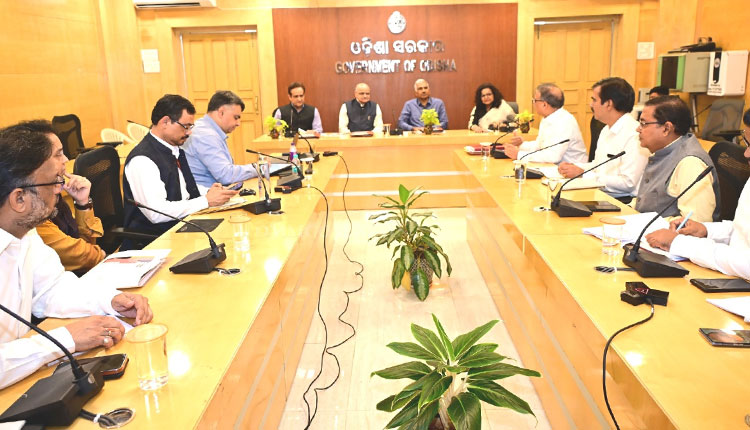NITI Aayog, Odisha Govt, and ISEG Join Hands for Clean Energy Transition

Tripartite pact to develop strategic roadmap for sustainable, cost-effective energy transition in Odisha
Bhubaneswar : In a major step toward a greener and more sustainable future, NITI Aayog, the Odisha government, and the Institute for Sustainability, Employment and Growth (ISEG) Foundation have signed a Statement of Intent (SoI) to collaborate on a transformative clean energy transition initiative in the state. The agreement, formalized in Bhubaneswar, marks a critical milestone in Odisha’s journey toward achieving its vision of “Viksit Odisha 2036” and contributing to the national mission of “Viksit Bharat 2047.”
The tripartite SoI was signed by Chief Secretary Manoj Ahuja on behalf of the Odisha government, B V R Subrahmanyam, CEO of NITI Aayog, and Shirish Sanke, Director and Founding Partner of the ISEG Foundation. Senior officials from the Ministry of Power and the Ministry of New and Renewable Energy were also present at the event.
Strategic Focus on Sustainable and Affordable Energy
The collaboration aims to develop and implement a strategic roadmap for a cost-effective energy transition plan that enhances sustainability, accessibility, and self-reliance in Odisha’s power sector. It seeks to accelerate the shift toward renewable energy sources, promote energy efficiency, and strengthen the state’s capacity for climate-resilient development.
Officials said the initiative will leverage the ASSET (Accelerating Sustainable State Energy Transition) platform — a joint program by NITI Aayog, the Ministry of Power, and the Ministry of New and Renewable Energy. The ASSET platform assists states in designing energy transition blueprints, creating scalable solutions, building institutional capacity, and facilitating access to global climate finance.
Through this partnership, Odisha will become one of the pioneer states to integrate ASSET’s tools and methodologies into its energy planning process, allowing for evidence-based policymaking and targeted investment in renewable and clean energy technologies.
Defined Roles for Effective Implementation
Under the agreement, NITI Aayog will provide strategic direction, coordinate with national-level stakeholders, and guide the development and review of the energy transition blueprint. The Odisha government, as the key implementing partner, will ensure data accessibility, inter-departmental coordination, and on-ground execution through relevant agencies.
The ISEG Foundation will serve as the technical and strategic partner, responsible for developing detailed energy demand-supply models, renewable energy strategies, and implementation frameworks. It will also assist in setting up an “Energy War Room” — a dedicated command and control center to monitor project execution, evaluate performance metrics, and identify challenges in real time.
Chief Secretary Manoj Ahuja emphasized the state’s commitment to achieving sustainable growth through efficient energy management and innovation. “This collaboration reflects Odisha’s proactive approach in building an energy-secure future that balances economic growth with environmental responsibility,” he said.
Institutional Framework for Monitoring
To ensure effective governance and accountability, the SoI outlines a two-tier monitoring structure. A Central Oversight Committee, chaired by the CEO of NITI Aayog, will oversee the overall progress and provide policy-level guidance. Meanwhile, a State Steering Committee, led by Odisha’s Principal Secretary of Energy, will coordinate implementation, review milestones, and recommend policy interventions as needed.
Officials noted that this framework will help ensure transparency, speed, and synergy among stakeholders involved in the clean energy mission. The committees will convene regularly to evaluate progress and align Odisha’s strategies with national and global energy transition goals.
Aligning with Odisha’s Vision 2036 and 2047
The partnership aligns closely with Odisha’s long-term development agenda under “Viksit Odisha @2036” and the national vision of “Viksit Bharat @2047.” The initiative underscores the state’s determination to lead India’s clean energy transition by adopting innovative policies, promoting green industries, and enhancing energy accessibility in both urban and rural areas.
Experts believe the collaboration could serve as a model for other states by demonstrating how public-private partnerships and data-driven policymaking can drive sustainable energy reforms. As Odisha moves toward becoming a low-carbon economy, the initiative promises to create new employment opportunities, reduce dependence on fossil fuels, and contribute significantly to India’s net-zero ambitions.
Also read:
Odisha to Host Urban Conclave 2025 to Shape Vision for ‘Viksit Odisha @2036’









